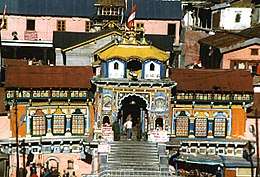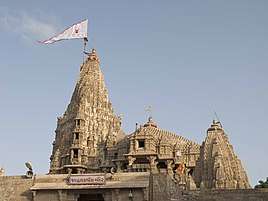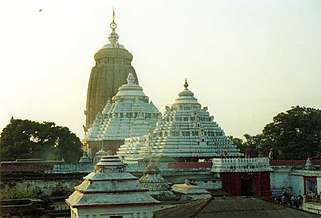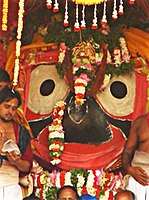Saty Narayan Ji Mandir, Nabha
The Saty Narayan Ji Temple in Nabha is a famous, sacred Hindu temple dedicated to Vishnu and located on the North of India, at Nabha in the state of Punjab.
| Thakur Saty Narayan Ji Temple at Nabha | |
|---|---|
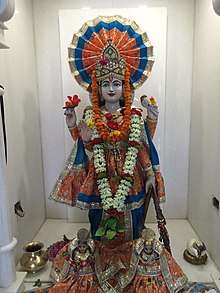 Lord Satya Narayan Ji inside temple | |
| Religion | |
| Affiliation | Hinduism |
| District | Patiala |
| Deity | Thakur Shri Saty Narayan Ji |
| Festivals | Ratha Yatra, Nabha Krishna Janmashtami Rama Navami |
| Location | |
| Location | Thakur Saty Narayan Mandir, Purani Nabhi, Nabha |
| State | Punjab |
| Country | |
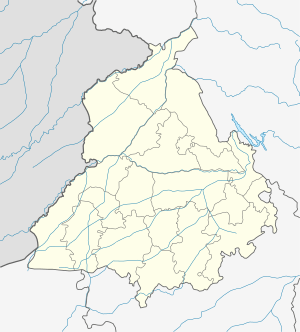 Location in Punjab | |
| Geographic coordinates | 30.375990°N 76.149702°E |
| Architecture | |
| Type | Modern Architecture |
| Completed | 1798 |
| Website | |
| https://facebook.com/thakursatynarayanji | |
The temple is an important pilgrimage destination for many Hindu traditions, particularly worshippers of Krishna and Vishnu, and ‘‘Char Dham pilgrimages that a Hindu is expected to make in one's lifetime.
Even though most Hindu deities that are worshiped are made out of stone or metal. Deity of This Temple is made of Stone.
The temple was built in the 18th century. This temple is 217 years old on date 27 May 2015. The temple is famous for celebrating Janamashtmi festival. On the occasion of Janamashtmi, the temple is decorated. Jhoolaah is made for Bal Gopal and is celebrated at night 12 AM. The temple is famous for its annual Ratha Yatra, or chariot festival, in which the three main temple deities are hauled on huge and elaborately decorated temple cars. Since medieval times, it is also associated with intense religious fervor. The First Ratha Yatra was held on 25 August 2014.
The temple is sacred to the Vaishnava traditions and saint Ramananda who was closely associated with the temple. It is also of particular significance to the followers of the Gaudiya Vaishnavism whose founder, Chaitanya Mahaprabhu, was attracted to the deity, Jagannath.
Deities
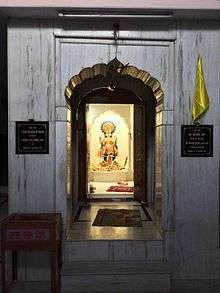
The central forms of Thakur Saty Narayan Ji and Bal Gopal (Laddu Gopal) constitute the goodness of deities. Thakur Saty Narayan Ji are in standing position. Thakur Ji are having for hands, holding Shankh, Sudarshan Chakra, Gadda and Hand in blessing position.
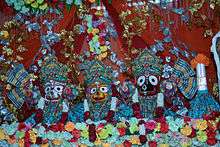
Origins of the temple
Thakur Saty Narayan Ji worship in the temple continued until 1995. First of all there was Small Statues of Saty Narayan Ji, But In 1995 Temple Management Committee (Committee Mandir Thakur Shri Saty Narayan Ji) Organized Murati Sthapna Samaroh and fix the bigger statue of Saty Narayan Ji, And Worshiped Till Present.
Legends, Pujari and Committee Members
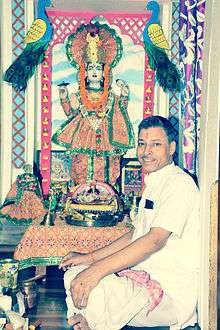
Brij Lal was the first Pujaari at the temple. He served at temple for 20 years. After him Pandit Dwarika Das came. He Belongs To Chamoli, district Uttarakhand. He done his service in the Temple for 18 years. After Dwarika Das a new pujaari came His Name Is Pandit Bachi Ram Joshi in 1989. He is a karm Kaandi Brahmin from Tehri Garhwal. His Guru is Pandit Bhagwat Parsad Joshi. Pandit Bachi Ram Joshi is Presently Living at The Temple, with his Family.
About the Temple
Shiva Pariwar
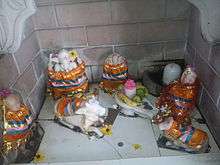
In the tmple if enters at left side of the temple Shiva is there and have statues of Ganesha, Kartikaya, Parvati, Nandi and Bhairav. There is a big hall is there in the temple where many festivals are celebrated Ganesh Chaturthi, Satynarayan Vrat Katha etc.
Mata Naina Devi
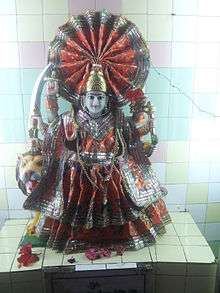
In That Hall Mata Naina Devi is there sitting on her ride Lion. This Statue of Mata Was Sthapith in 1980.
Radha Krishna
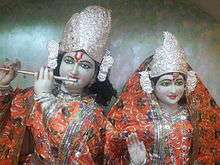
Entry and Darshan
Temple has one entrance in all directions. Everyone is allowed entry. Practicing Hindus of non-Indian descent are excluded from premises. Every day there are two Aarties are Performed of Thakur Saty Narayan Ji. No time is fixed for Aarti because Aarti is done at the time of sun set.
Cultural Integrity
We can verily be said to be a truthful replica of Indian culture. To understand this culture, one has to have some idea of the history of this land, which again is different from that of other countries of the world.
Starting from Lord Jagannath himself, history has it that he was a tribal deity, adorned by the Sabar people, as a symbol of Narayana. Another legend claims him to be Nilamadhava, an image of Narayana made of blue stone and worshipped by the aboriginals. He was brought to Nilagiri (blue mountain) or Nilachala and installed there as Shri Jagannath in company with Balabhadra and Subhadra. The images made of wood are also claimed to have their distant linkage with the aboriginal system of worshipping wooden poles. To cap it all the Daitapatis, who have a fair share of responsibilities to perform rituals of the Temple, are claimed to be descendants of the aboriginals or hill tribes of Orissa. So we may safely claim that the beginning of the cultural history of Shrikshetra is found in the fusion of Hindu and Tribal Cultures. This has been accepted as a facet of our proud heritage. The three deities came to be claimed as the symbols of Samyak Darshan, Samyak Jnana and Samyak Charita usually regarded as Triratha (of the Jain cult), an assimilation of which leads to Moksha (salvation) or the ultimate bliss...
Jagannath is worshipped as Vishnu or Narayana or Krishna and Lord Balabhadra as Shesha. Simultaneously, the deities are regarded as the bhairava with Vimala (the devi or the consort of Shiva) installed in the campus of the temple. So ultimately we find a fusion of Saivism, Shaktism and Vaishnavism of the Hindu religion with Jainism and up to an extent Buddhism in the culture of Jagannath and the cultural tradition so reverently held together in Shrikshetra.
About Char Dham
| Char Dham
Dwaraka • Puri |
|---|
The temple of Jagannath Puri is one of the holiest Hindu Char Dham (four divine sites) sites comprising Rameswaram, Badrinath, Puri and Dwarka.[1] Though the origins are not clearly known, the Advaita school of Hinduism propagated by Sankaracharya, who created Hindu monastic institutions across India, attributes the origin of Char Dham to the seer.[2] The four monasteries lie across the four corners of India and their attendant temples are Badrinath Temple at Badrinath in the North, Jagannath Temple at Puri in the East, Dwarakadheesh Temple at Dwarka in the West and Ramanathaswamy Temple at Rameswaram in the South. Though ideologically the temples are divided between the sects of Hinduism, namely Saivism and Vaishnavism, the Char Dham pilgrimage is an all Hindu affair.[3] There are four abodes in Himalayas called Chota Char Dham (Chota meaning small): Badrinath, Kedarnath, Gangotri and Yamunotri - all of these lie at the foot hills of Himalayas [4] The name Chota was added during the mid of 20th century to differentiate the original Char Dhams. The journey across the four cardinal points in India is considered sacred by Hindus who aspire to visit these temples once in their lifetime.[5] Traditionally the trip starts at the eastern end from Puri, proceeding in clockwise direction in a manner typically followed for circumambulation in Hindu temples.[5]
Structure
The huge temple complex covers an area of over 350 square feet (33 m2), and is surrounded by a high fortified wall. The temple has four distinct sectional structures, namely -
- Deula, Vimana or Garba griha (Sanctum sanctorum) where the triad deities are lodged on the ratnavedi (Throne of Pearls). In Rekha Deula style;
- Mukhashala (Frontal porch);
Among the existing temples in Nabha, the temple of Thakur Shri Saty Narayan Ji is the highest. The temple tower was built on a raised platform of stone and, rising to sky above the inner sanctum where the deities reside, dominates the surrounding landscape. The pyramidal roofs of the surrounding temples and adjoining halls, or mandapas, rise in steps toward the tower like a ridge of mountain peaks.
Minor Temples
There are numerous smaller temples and shrines within the Temple complex where active worship is regularly conducted. The Mata Naina Devi is considered one of the most important of the Shaktipeeths
The temple of Hanuman has an important role. He is in Ramayan Rama, Hanuman and Eshaneshwara.
The Mandapas
There are many Mandapas or Pillared halls on raised platforms within the temple complex meant for religious congregations. The most prominent is the Mukti Mandapa the congregation hall of the holy seat of selected learned Brahmins.
Daily Food Offerings
Daily offerings are made to the Lord Two times a day. These include:
- The offering to the Lord in the Morning that forms His breakfast and is called The Gopala Vallabha Bhoga. Breakfast is a seven item treat - Makhan Mishri, curd and ripe bananas.
- The last offering to the Lord is called the Bada Simhara Bhoga At Sun Set Aarti.
Festivals
In Saty Narayan Ji Temple every festival of Sanatan Dharma is ceberated with Love. Shri Krishna Janamashtmi is the most important festival of the temple. Birthday of lord Krishna is celebrated at mid night. There are elaborate daily worship services. There are many festivals each year attended by hundreds of people. The most important festival is the Rath Yatra or the Chariot festival. This spectacular festival includes a procession of huge chariot bearing the idols of Jagannath, Balabhadra and Subhadra through the Devi Chowk meaning the Grand Avenue of Nabha till their final destination the Saty Narayan Ji Temple.
Early European observers told tales of devotees being crushed under the wheels of this chariot, whether by accident or even as a form of meritorious suicide akin to suttee. These reports gave rise to the loan word juggernaut suggesting an immense, unstoppable, threatening entity or process operated by fanatics. Many festivals, There are special ceremonies in the month of Kartika.
Rath Yatra at Saty Narayan Mandir, Nabha
The Jagannath triad are usually worshiped in the sanctum of the temple at Puri, but Shri Saty Narayan Ji Mandir Commi tee once during the year (usually falling in month of August or September), they are brought Jagannath out onto the Devi Chowk (main street of Nabha) and travel to the Shri Saty Narayan Ji, Temple in huge chariot (ratha), allowing the public to have darśana (Holy view). This festival is known as Ratha Yatra, meaning the journey (yatra) of the chariot (ratha). The Ratha is huge wheeled wooden structure, which is built anew every year and are pulled by the devotees. The chariot for Jagannath is approximately 20 feet high and 15 feet square and takes about 1 week to construct. The Committee Members, artists and painters of Nabha, Dhuri decorate the car and paint flower petals and other designs on the wheels, the wood-carved charioteer and horses, and the inverted lotuses on the wall behind the throne. The huge chariot of Jagannath pulled during Rath Yatra is the etymological origin of the English word Juggernaut. The Ratha-Yatra is also termed as the Shri Gundicha yatra.
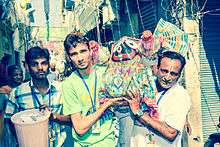
The most significant ritual associated with the Ratha-Yatra is the chhera pahara. During the festival, people wears the outfit of a sweeper and sweeps all around the deities and chariot in the Chera Pahara (sweeping with water) ritual. King cleanses the road before the chariots with a gold-handled broom and sprinkles sandalwood water and powder with utmost devotion. As per the custom, although the King has been considered the most exalted person in the kingdom, he still renders the menial service to Jagannath. This ritual signified that under the lordship of Jagannath, there is no distinction between the powerful sovereign King and the most humble devotee. Jagannath Katha is held on Seven days before, on the first day of the Ratha Yatra, the last day of the festival, when the deities are ceremoniously brought back to the Shri Mandir.
In the Ratha Yatra, the three deities are taken from the Jagannath Temple in the chariot.
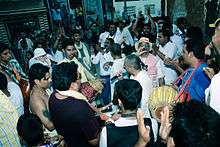
The observance of the Rath Yatra dates back to the period of the Puranas. Vivid descriptions of this festival are found in Brahma Purana, Padma Purana, and Skanda Purana. Kapila Samhita also refers to Rath Yatra. In Moghul period also, King Ramsingh of Jaipur, Rajasthan has been described as organizing the Rath Yatra in the 18th Century. In Orissa, Kings of Mayurbhanj and Parlakhemundi were organizing the Rath Yatra, though the grandest festival in terms of scale and popularity takes place at Puri.
Moreover, Starza[6] notes that the ruling Ganga dynasty instituted the Rath Yatra at the completion of the great temple around 1150 AD. This festival was one of those Hindu festivals that was reported to the Western world very early. Friar Odoric of Pordenone visited India in 1316-1318, some 20 years after Marco Polo had dictated the account of his travels while in a Genoese prison.[7] In his own account of 1321, Odoric reported how the people put the "idols" on chariots, and the King and Queen and all the people drew them from the "church" with song and music.[8] [9]
Snana Purnima
On the Purnima of the month of Jyestha the Gods are ceremonially bathed and decorated every year on the occasion of Snana Yatra.
Chandrayan Vrat or Purnima
Chandrayan Vrat in Punjab is commonly known as Purnima Vrat, but it’s not purnima vrat. Chandrayan Vrat comes every month near the purnima, sometimes on purnima, sometime it comes before the purnima. On the occasion of purnima. Saty Narayan Vrat Katha is held in the temple. After the Saty Narayan JiKatha Aarti is performed. After aarti maha prashad is distributed among the devotees. Kheer is distributed as maha bhog. Chandrayan Vrat has very much importance. It is the main day of Bhagwaan Saty Narayan Ji in that month.
Gupta Gundicha
Celebrated for 16 days from Ashwina Krushna dwitiya to Vijayadashami.[10] As per tradition, the idol of Madhaba, along with the idol of Goddess Durga (known as Durgamadhaba), is taken on a tour of the temple premises. The tour within the temple is observed for the first eight days. For the next eight days, the idols are taken outside the temple on a palanquin to the nearby Narayani temple situated in the Dolamandapa lane. After their worship, they are brought back to the temple.[11]
The name Purushottama Kshetra and Its Significance
Lord Thakur Shri Saty Narayan Ji is the Purushottama as per the scripture, Skanda Purana. In order to teach human beings how to lead a life full of virtue, he has taken the form of Saguna Brahman or Darubrahman. He is the best brother to his siblings, Lord Balabhadra and Devi Subhadra. He is the best husband to goddess Shri. The most noteworthy aspect is still in the month of Margashirsha, on three consecutive days during amavasya he does Shraddha to his parents (Kashyapa-Aditi, Dasharatha-Kaushalya, Vasudeva-Devaki, Nanda-Yashoda), along with the king Indradyumna and queen Gundicha. As a master he enjoys every comfort daily and in various festivals. He grants all wishes to his subjects, and those who surrender before him he takes the utmost care of.
Culture and Tradition of Nabha
Nabha is one of the fascinating littoral Town of Punjab. The Cultural heritage of Nabha with its long recorded history has its beginnings in the third century B.C. The monuments, religious sanctity, and way of life of the people with their rich tradition is the cultural heart of Punjab. Indeed, Nabha is considered the cultural capital of Nabha. The culture here flourished with its manifold activities.
The Town has the happy conglomerate of different religions, sects and faith. In the course of history, Hindu, Buddhist, Jaina, Muslim, Christian, and Sikh are found here in the town.
Chaitanya Mahaprabhu, an incarnation of Lord Krishna, appeared 500 years ago, in the mood of a devotee to taste the sublime emotions of ecstasy by chanting the holy name of Krishna. Stalwart scholars of Puri like Sarvabhauma Bhattacharya (a priest & great Sanskrit pandit) and others followed His teachings. Even kings and ministers of His period became His disciples. Especially King Prataparudra became His great admirer and ardent follower. Thus all cultures and religion became one in Puri after his teachings were given to all with no consideration of caste and creed.
Security
The security at the Saty Narayan Temple is increased ahead of Ratha Yatra, the homecoming festival of the deities of Saty Narayan Ji temple. In the wake of terror alert on 27 June 2012, the security forces were increased to ensure smooth functioning of the crowded Ratha Yatra. Punjab Police makesthe security for The Ratha Yatra.
References
- Chakravarti 1994, p. 140
- Mittal, Sushil (2004). The Hindu World. New York: Routledge. pp. 482. ISBN 0-203-64470-0.
- Brockman 2011, pp. 94-96
- Gupta 2008, p. 484-486
- last=Gwynne 2008, Section on Char Dham
- Starza 1993, p. 133.
- Mitter 1977, p. 10.
- Starza 1993, p. 129.
- Das 1982, p. 48.
- Panda, Namita (11 October 2010). "The Telegraph - Calcutta (Kolkata) | Orissa | Gupta Gundicha attracts devotees". telegraphindia.com. Calcutta, India. Retrieved 20 December 2012.
Beginning from Ashwina Krishna dwitiya to the last day of Dusherra,
- "Gupta Gundicha In Srikhetra – Start of Durga Madhab worshiping | PURIWAVES". puriwaves.nirmalya.in. Retrieved 20 December 2012.
The Vimanbadu servants ( who carry the chariot) carry Sri Durga – Madhab ( Sri Jagannath & Jaya Durga ) in a chariot to the temple of Narayani at Dolamandap Sahi.
External links
| Wikimedia Commons has media related to Saty Narayan Ji Mandir, Nabha. |
